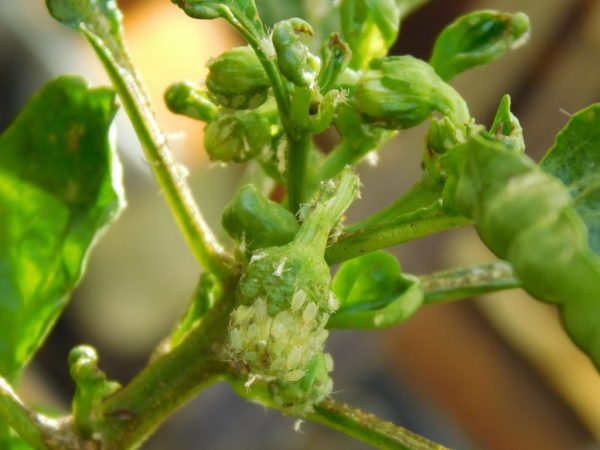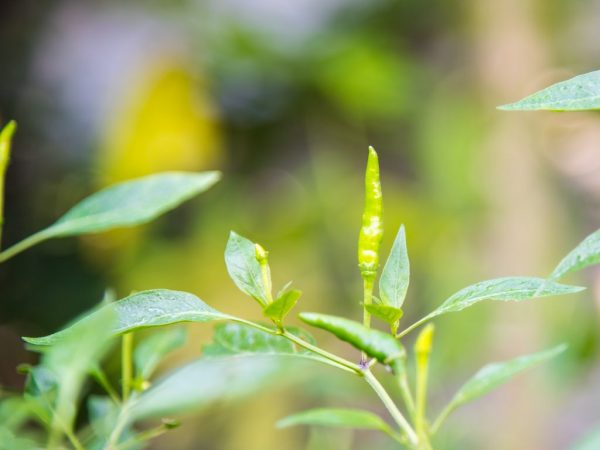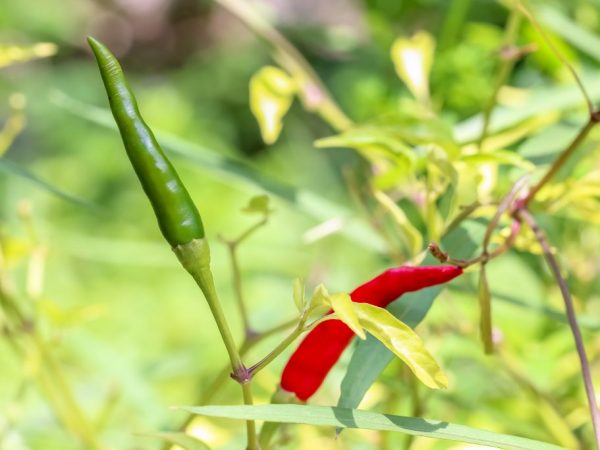Why do the leaves of pepper seedlings curl
Any seedling of vegetables can be exposed to various diseases and pests. As a result, the plant develops disproportionately and deforms. The leaves of pepper seedlings are curled due to pests and the lack of the necessary conditions for development.

The leaves of pepper seedlings are curled
First symptoms
Identifying the first signs of curling allows you to start treatment on time in order to grow a healthy and strong pepper bush. Ignoring the first signs can lead to death.
The first symptoms of twisting may be:
- gradual yellowing;
- the appearance of a cobweb;
- deformation of leaves along the median vein;
- white bloom and holes on the shoots;
- curling into a tube and lowering the leaves down.
After that, the bush begins to dry out gradually, and the plant completely dies. Careful supervision and timely elimination of the first symptoms will help prevent the death of seedlings.
Main reasons
Twisting can be caused by:
- unsuitable temperature regime;
- poor development of the root system;
- uneven development of the leaf plate;
- lack of nutrients;
- the presence of pests or infections.
Pest or infection control comes with a cost and labor cost. It is necessary to eliminate the causes immediately, as soon as deviations in the development of the plant are discovered.
Temperature regime
Pepper is a vegetable that comes from warm countries. For him, light and the right temperature are important. A sudden cold snap or insufficient heat leads to curling and discoloration of the leaves. They can first turn pale and curl, turn yellow, and then gradually dry out. If the seedlings are planted in the ground, then this deformation will take place gradually.
Not only lack of heat, but also excessive dry weather harms the seedlings. Due to the bright sun and high temperatures, the plant tries to reduce the evaporation area, so the upper leaves begin to curl.
If there is a lack of heat, the greenhouse is warmed up or additional lighting is installed. And with excessive stuffiness, the greenhouse needs to be ventilated.
Poor root development

Be sure to take care of the plants
Insufficient development of the root system can occur due to the presence of larvae of various pests. They not only damage the root of the plant, but also the entire sprout. Because of what the leaves of the pepper seedlings curl. If you do not carry out a timely fight against the larvae of parasites, then in the spring they will ruin the entire crop.
The accrete roots of the seedlings can provoke such a deformation of the leaf plate. This is due to closely planted seedlings. As a result, the roots cannot receive a sufficient amount of the necessary useful elements.
Uneven plate development
One of the most common causes of leaf curl. This is due to the rapid growth of the central vein.The leaf grows in length, and its surface does not keep up with it. Most often, the upper shoots are twisted.
Such curling does not harm the development and formation of further crops. Over time, the leaves will take on a normal shape.
Lack of nutrients
With a lack of essential trace elements, pepper leaves can not only curl, but also fall off. The seedling itself will develop poorly and give a poor harvest.
Potassium
Shortage signs:
- yellowness appears;
- the edges of the leaves begin to dry;
- a small harvest is possible;
- the fruits will be small.
The amount of potassium depends on the soil in which the seedling is planted. Clay and loamy soils contain a sufficient amount of trace elements. In peat and sandy soils, they are not enough for full growth.
Phosphorus
With a lack of phosphorus, the leaves acquire a blue or green tint, the stem of the seedling can turn red-purple. The leaf plate bends over time, the flowering period is delayed and as a result the seedling is depleted and dies.
Nitrogen
Nitrogen deficiency manifests itself in the pale color of the shoots. The plates are curled around the edges and yellow spots are formed.
As well as the lack of microelements, their excess harms the seedling. At first, the seedling grows quickly, then the leaves of the pepper seedlings curl. In this case, the ovary may not appear near the bush.
Pests
When infected with spider mites and aphids, the following signs may be observed:
- the formation of a web between shoots;
- partial or complete yellowing;
- the leaves curl into a tube and fall off.
Aphid

Aphids are very dangerous
Aphids first damage young seedlings. Starting from the bottom of the plant, it moves up and depletes the plant, sucking out all the juices. Because of this, the bushes do not develop gradually and cannot form the necessary ovary. Aphids appear on bushes that grow in the desired temperature range, are watered in a timely manner and are not subject to drafts.
Mite
The spider mite is almost invisible. It can be recognized by the cobweb between the leaves and grooves. From the bush, it destroys all nutrients, leading to the death of the pepper. It can appear on a bush even before disembarking in open ground. Due to its microscopic size, it cannot move and gets onto the seedlings from infected tools.
Infections
Top rot is characterized by:
- curling and curling of leaves;
- dark spots on the fruit;
- rotting fruit.
Rot is caused by insufficient watering or potassium in the soil. And also an excess of nitrogen can provoke the disease.
Control methods
Having identified the first symptoms and causes of twisting, it is necessary to choose methods of struggle.
Distance between plants
For the normal development of the root system, the bushes are planted at a sufficient distance. When transplanting, you need to straighten the roots and only then plant them in the soil. At night, you can cover the seedlings with lutrasil or other covering material.
Top dressing
To determine which trace element is lacking in a seedling, you need to feed it with one of the nutrients. If the plant returns to normal in 1-2 days, then the missing element is determined. This is one of the easiest ways to solve such a problem. You can also make complex fertilizers. They are prepared in the same way as a simple top dressing, but the dose is reduced several times.
Periodically, the soil can be fertilized with poultry droppings, which contain all the necessary nutrients. Only from him the effect will not be immediately noticeable.
Wood ash is often used for feeding. You must adhere to these rules:
- The soil under each bush is evenly sprinkled with ash.
- The layer thickness should be 3 mm.
- After that, you need to water the seedlings.
Wood ash can be applied in the fall, before digging, or in the spring before planting.
For a quick effect, potassium nitrate is used instead of wood ash. In 10 liters of water, you need to dissolve 2 tbsp. tablespoons of saltpeter.Pour 0.5 liters of such a solution under each bush. Before applying potassium nitrate, the soil must first be moistened.
Pest prevention

Pest control in different ways
Aphid
If a bush that has fruits or is in the flowering period has damaged aphids, you need to inspect it manually. In this case, the leaves are washed with warm water.
Some gardeners practice planting mustard, basil or dill next to pepper seedlings. Their pungent smell repels aphids. Ladybugs and other insects that feed on aphids will help in the fight against this pest.
Solutions
Folk remedies also help in the fight against pests. They are budgetary, but time consuming to prepare. Use different decoctions and infusions:
- Onion husks. In 1 liter of water, 1 glass of onion peel is added and infused all day. You need to spray the bushes every 5 days.
- Dandelion and garlic. A mixture of garlic and dandelions is made, 1 tablespoon of honey is added. The resulting mass is dissolved in a bucket of water. After 3 hours of infusion, you can process the pepper bushes.
You can add dried potato or tomato tops to the mixture. A solution of tar soap (10 grams per 5 liters of liquid) or calendula. Such solutions will relieve the invasion of aphids.
It is necessary to process not only damaged areas and bushes, but also neighboring plants. This will prevent aphids from multiplying and damaging crops.
Spraying the soil with a weak solution of potassium permanganate will help get rid of the larvae. Warming up the soil will help to destroy pests. This should be done for 14 days. Another option is to water the place where the seedling will be planted with boiling water 2 days before planting.
Mite
In the fight against spider mites, infusions of onion husks or garlic, the same as with aphids, will help. He quickly adapts to such funds, so they should be alternated. You can use chemicals that are aimed at destroying the pest.
It is recommended to treat greenhouses in which a tick has wound up with a solution of chlorine lime. To do this, dilute 200 g of the product in 10 liters of water.
Prophylaxis
To prevent the spread of fungi and infectious diseases, you need to process inventory and greenhouses. Some pathogens can live for several years.
Keeping the crop rotated and tilling the soil after previous crops will reduce bacterial growth. To disinfect the soil, you need to water it with boiling water 2 days before sowing.
Proven and effective plant protection products should be used to treat plants. To prevent transmission of infection, weeds should be removed from the planted area.
It is better to grow peppers at an air temperature of 19-23 ° C. To eliminate dry air, it is necessary to spray the seedlings. At home, you can use a spray bottle.
Conclusion
Very often, the cause of leaf curling in pepper seedlings is an incorrect agrotechnical process. The first signs can be eliminated by temperature and timely watering.
In order for the pepper to be strong and produce a crop, it is necessary to properly care for and spray from pests. Regularly inspect the bushes and monitor if the leaves are curled or in excellent condition.


